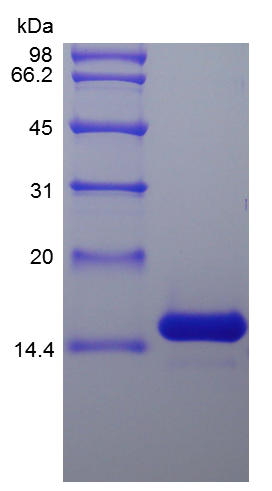- Synonyms
-
- Source
- Escherichia coli.
- Molecular Weight
- Approximately 14. 9 kDa, a single non-glycosylated polypeptide chain containing 129 amino acids.
- AA Sequence
- DCHIKDKDGK AFGSVLMISI NQLDKMTGTD SDCPNNEPNF FKKHLCDDTK EAAFLNRAAR KLRQFLKMNI SEEFNDHLLR VSDGTQTLVN CTSKEEKTIK EQKKNDPCFL KRLLREIKTC WNKILKGSI
- Purity
- > 95 % by SDS-PAGE and HPLC analyses.
- Biological Activity
- Fully biologically active when compared to standard. The ED50 as determined by a cell proliferation assay using murine 2E8 cells is less than 2.0 ng/ml, corresponding to a specific activity of > 5.0 × 105 IU/mg.
- Physical Appearance
- Sterile Filtered White lyophilized (freeze-dried) powder.
- Formulation
- Lyophilized from a 0.2 µm filtered concentrated solution in PBS, pH 7.4.
- Endotoxin
- Less than 1 EU/µg of rRtIL-7 as determined by LAL method.
- Reconstitution
- We recommend that this vial be briefly centrifuged prior to opening to bring the contents to the bottom. Reconstitute in sterile distilled water or aqueous buffer containing 0.1 % BSA to a concentration of 0.1-1.0 mg/ml. Stock solutions should be apportioned into working aliquots and stored at ≤ -20 °C. Further dilutions should be made in appropriate buffered solutions.
- Stability & Storage
- Use a manual defrost freezer and avoid repeated freeze-thaw cycles.
- 12 months from date of receipt, -20 to -70 °C as supplied.
- 1 month, 2 to 8 °C under sterile conditions after reconstitution.
- 3 months, -20 to -70 °C under sterile conditions after reconstitution.
- Usage
- This material is offered by Shanghai PrimeGene Bio-Tech for research, laboratory or further evaluation purposes. NOT FOR HUMAN USE.
- SDS-PAGE

- Reference
- 1. Goodwin RG, Lupton S, Schmierer A, et al. 1989. Proc Natl Acad Sci U S A. 86:302-6.
2. Sutherland GR, Baker E, Fernandez KE, et al. 1989. Hum Genet. 82:371-2.
3. Lupton SD, Gimpel S, Jerzy R, et al. 1990. J Immunol. 144:3592-601.
4. Noguchi M, Nakamura Y, Russell SM, et al. 1993. Science. 262:1877-80.
5. Fry TJ, Mackall CL. 2002. Blood. 99:3892-904.
6. Fry TJ, Mackall CL. 2002. J Hematother Stem Cell Res. 11:803-7.
- Background
- Interleukin-7 (IL-7) is encoded by the IL7 gene and secreted by stromal cells in the red marrow and thymus. It binds to the IL-7 receptor, a heterodimer consisting of IL-7 receptor alpha and IL-2 receptor gamma chain. IL-7 stimulates the differentiation of hematopoietic stem cells into lymphoid progenitor cells and also stimulates proliferation of B cells, T cells and NK cells. Furthermore, IL-7 as an immunotherapy agent has been examined in many human clinical trials for various malignancies and during HIV infection. Rat IL-7 contains 129 amino acid residues and has three disulfide bonds. In addition, it has approximately 57 % and 88 % amino acid sequence identity with human and murine IL-7.

 COA申请
COA申请
